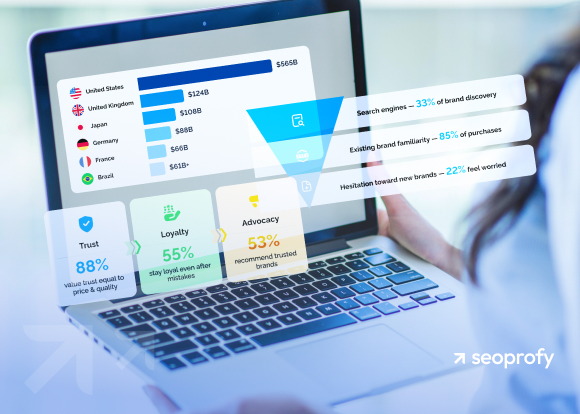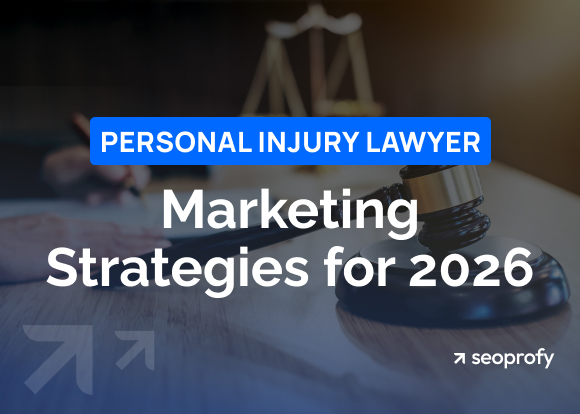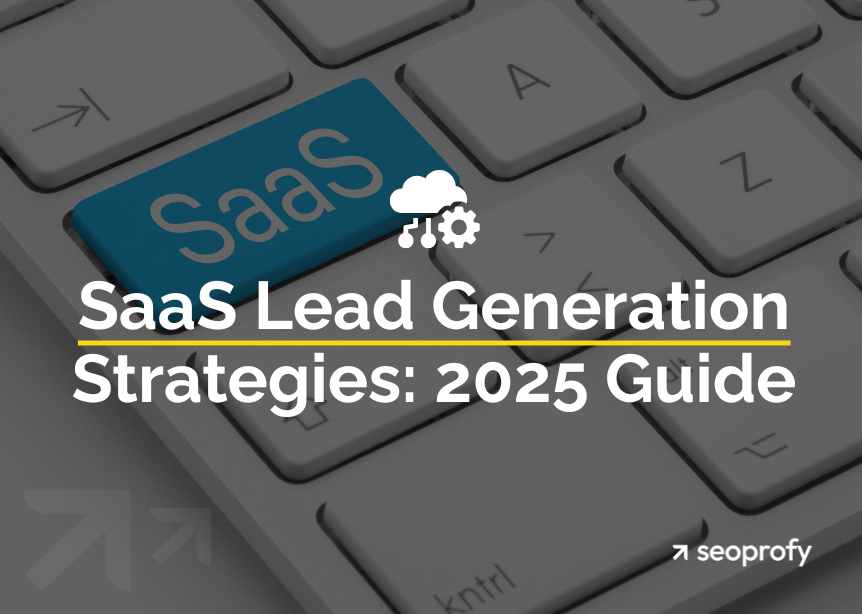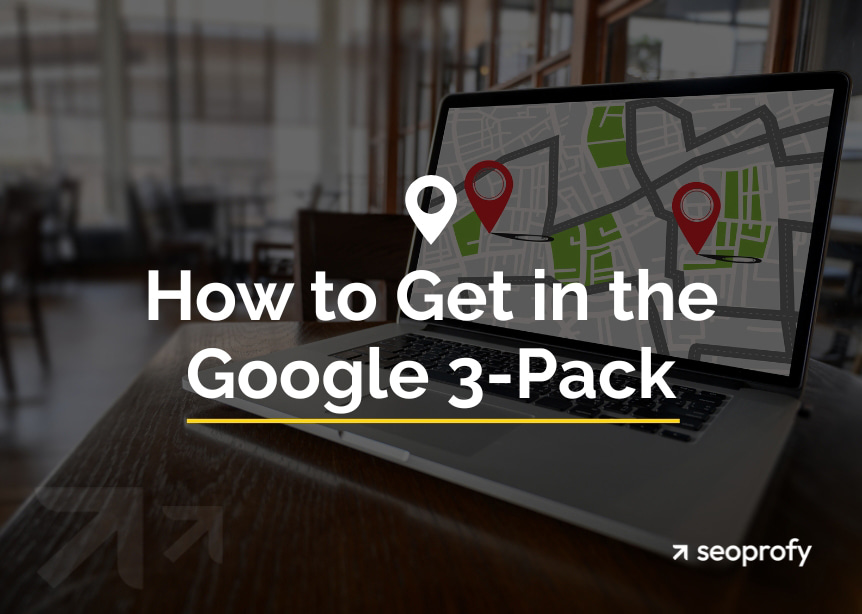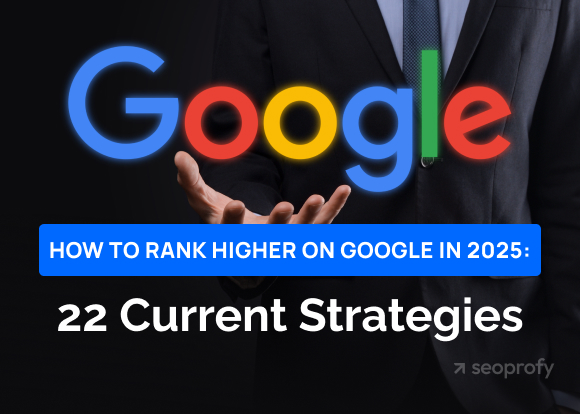SEO is one of the main customer acquisition channels for B2B companies. Moreover, the results from a well-planned B2B SEO strategy are compounding, with businesses able to generate leads at every stage of the marketing funnel consistently.
In this guide, we’ll explain how B2B SEO works, how it differs from B2C, and how to create content that drives more prospective customers to your site. We’ll also share proven link building strategies and give you practical SEO tips you can start using right away.
- B2B search engine optimization starts with creating customer personas to learn their pain points, needs, and motivations.
- In B2B, your content needs to appeal to multiple stakeholders, from executives to various teams.
- Keywords with low search volume but a clear buying intent are usually more important for businesses than broad terms.
- Content strategy for B2B SEO should address questions your prospective customers might have and move them through a buying process.
- Links from respected industry sites, collaborations, and research can strengthen trust and boost your search visibility.
What is B2B SEO?
B2B SEO is a planned strategy to enhance your website’s visibility in search engines so you can attract organic traffic and rank higher for relevant keywords. And it’s actually one of the most popular channels for B2B marketing, according to the 2023 Marketing Mix Report.
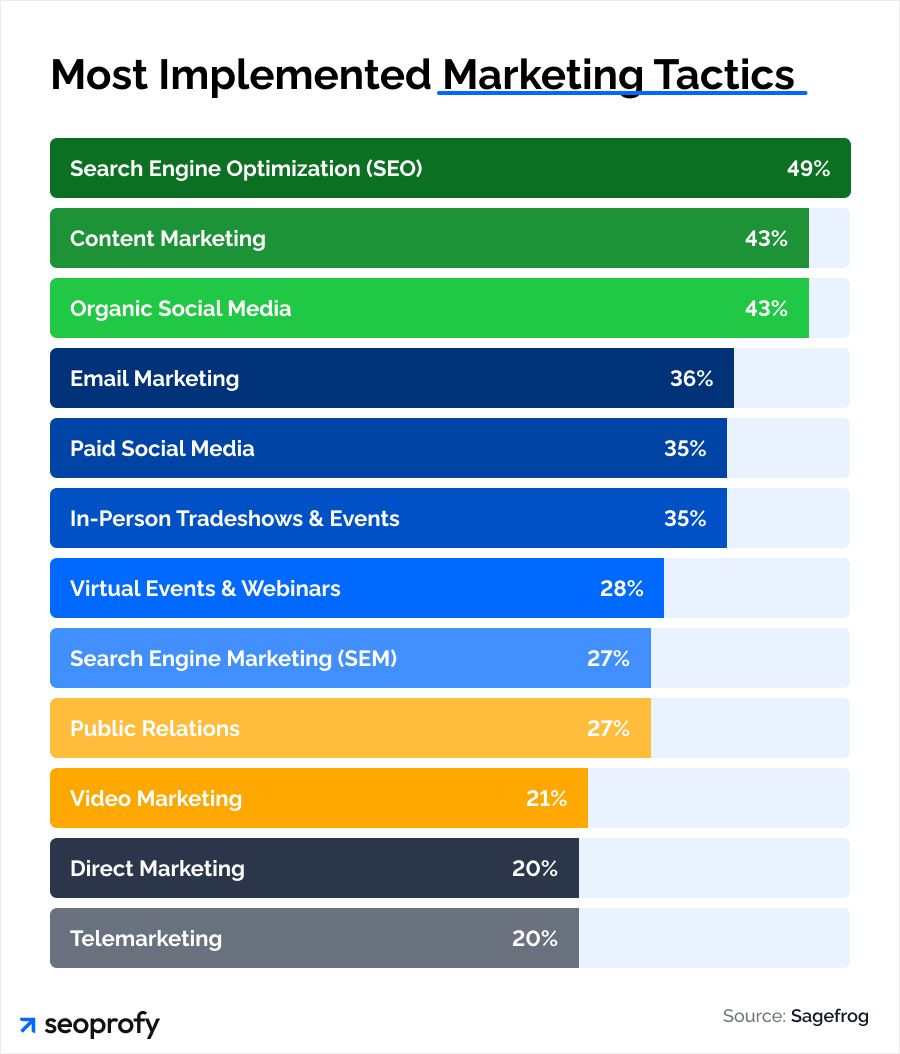
Let’s now look at the common tactics that go into a successful B2B SEO strategy:
- Keyword research. In B2B SEO, it’s important to target niche keywords that match what your potential clients are searching for. Search volume plays a less critical role in this context; it’s more effective to focus on other factors, such as relevance and user intent.
- On-page SEO. It involves optimizing titles and meta descriptions, images, headings, and subheadings with relevant keywords. So your users and search engines can find you in search results.
- Off-page SEO. The activities outside your site, like getting other authoritative websites to link to you, are part of off-page SEO. Securing these links builds authority and signals credibility to Google. Furthermore, it improves your rankings in search engines.
- Technical SEO. That’s what keeps your web pages functional and accessible. This includes optimizing load times and mobile usability, fixing broken links, and maintaining proper site indexing.
- Content Writing. Business leaders require content to see how your product or service can help their company. They look for resources like guides, case studies, and use cases to understand your expertise.
Now, let’s look at how B2B SEO differs from B2C.
B2B SEO vs. B2C SEO: Key Differences
Google uses the same ranking factors for both, and there isn’t a separate algorithm for B2B sites. The general SEO practices used for B2C will also work for B2B, but there are still some clear differences to keep in mind:
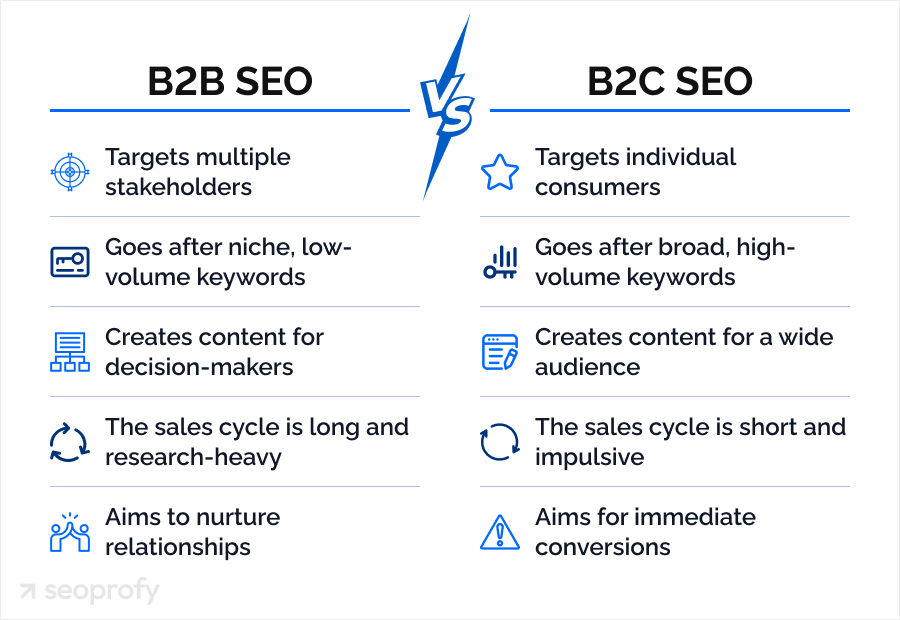
Longer Sales Cycles
B2B sales funnels are longer and involve more than one person. Sometimes, it can take weeks or even months for businesses to convert, particularly within the SaaS niche.
If you’re looking for time-tracking software for your team, you’d likely want to find out how it integrates with other tools, whether it has the features you need, and if it fits your budget. Getting all this information will take some time.
On the other hand, B2C purchases are a lot faster and require less convincing, so to speak. For example, if you want to buy new shoes, you will look at a few of them, compare your options, and purchase the pair that would suit your needs.
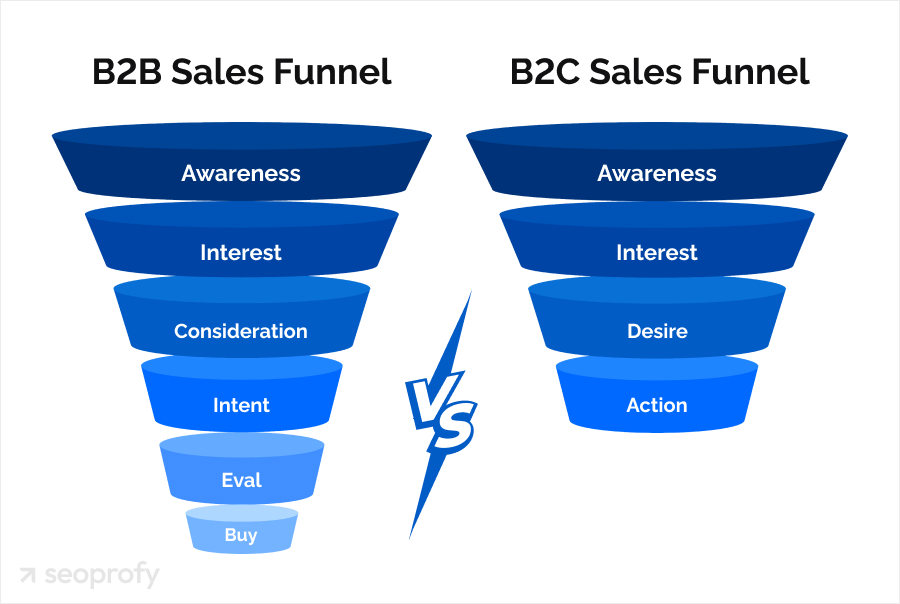
Low-Volume, High-Intent Keywords
B2B searches are narrower because they are more specific. Keywords like “project management software” have lower search volumes compared to broad queries like “best headphones.”
But these keywords have high intent, as people who look for them are more inclined to buy. In contrast, B2C often targets high-volume keywords to drive more traffic.
For example, such sites can go for terms with thousands of searches, while in B2B SEO strategy, it’s normal to target keywords with just 100 or even 20 searches a month.
Targeting Decision-Makers
In B2B, you’re speaking to C-level executives or other stakeholders who make decisions on behalf of their company. If we compare it to B2C companies, the situation looks completely different since their target market is a broad demographic group rather than a specific audience.
Emphasis on Brand Authority
Every person wants to trust the company they’re buying from, but B2B clients are even more cautious. Before they fill out a form or make a call, they want to know that your product can solve their problem. They’re looking for someone who can deliver exactly what they’re looking for.
To build trust, your business needs to showcase expertise and authority. You can do this through:
- Blogging
- Case studies
- Article contributions
- Podcasts
- Speaking at industry events
How to Build a Winning B2B SEO Strategy
Now that you understand the differences between these types of businesses, let’s look at how you can create a strategy using our B2B SEO guide:
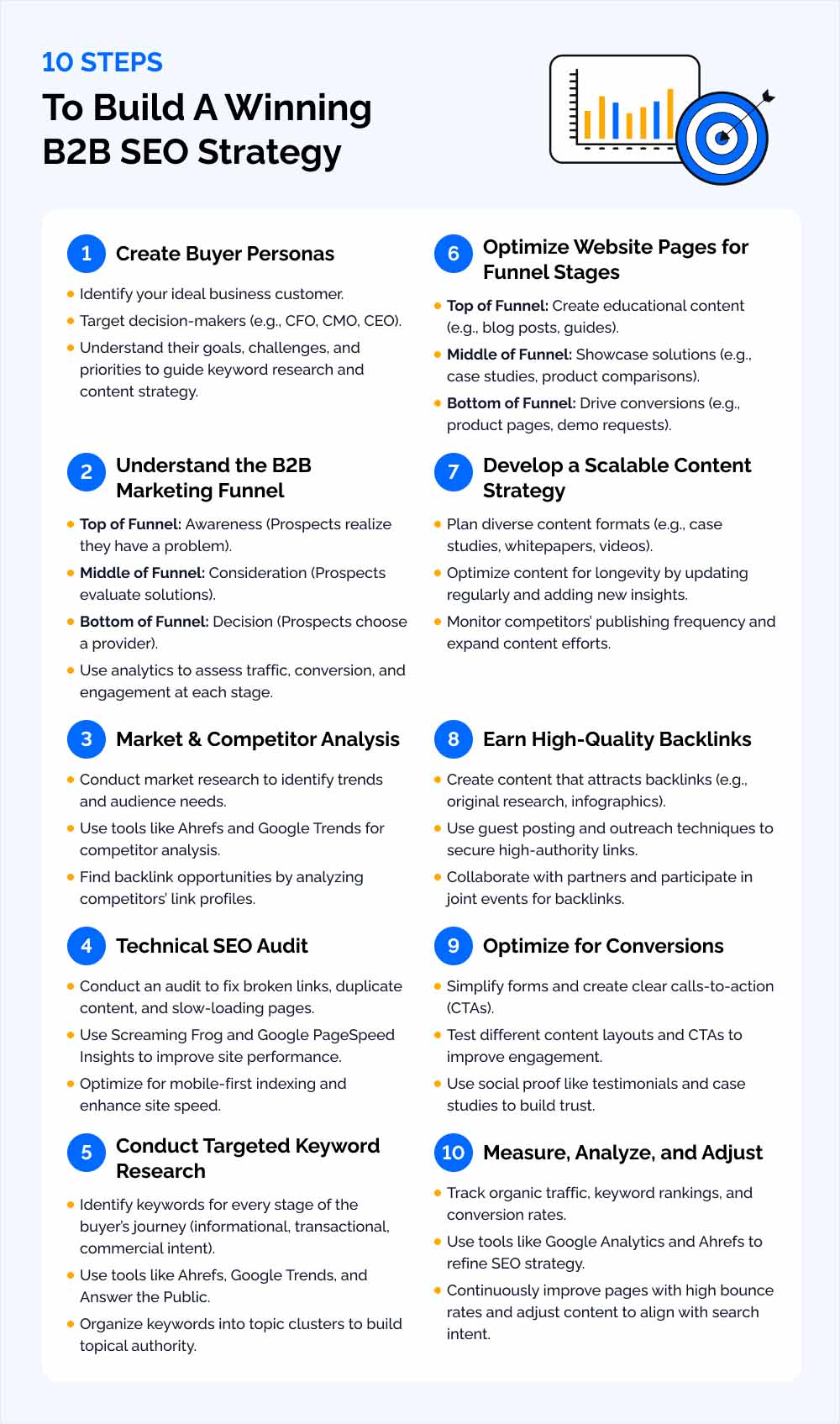
Step 1: Create Buyer Personas
A buyer persona is a profile of your ideal customer. For B2B SEO, it can be trickier to define this persona because you’re targeting a business, not just one person.
So you need to determine exactly who you’re trying to reach within that business. Is it the CFO, CMO, CEO, or someone else? What goals do they wish to achieve, and what factors might influence their decisions, such as price or ease of use?
Once you have answers to these questions, you could use them to guide both your keyword research and your content strategy. To help you get started, you can use a free customer persona template from Miro:
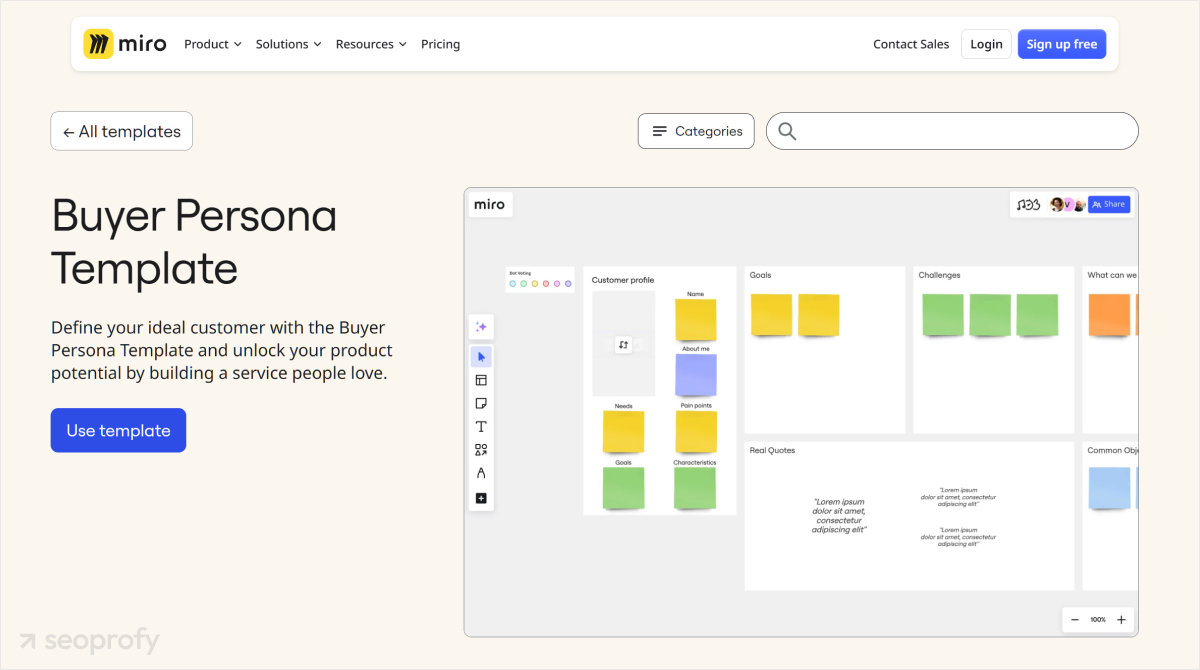
Step 2: Understand the B2B Marketing Funnel
A B2B marketing funnel is the path your potential customers follow, from realizing they have a problem (top of the funnel) to deciding to work with your business (bottom of the funnel)
If you’re not familiar with how it works in your company, here’s how you can approach it:
- Talk to your sales team. Ask them to explain the different stages of the funnel, where prospects usually come in, and what questions or concerns they have at each step. Find out which pages tend to convert leads and where they usually drop off.
- Look at your existing data. Use Google Analytics 4 to track where your website traffic comes from and how visitors move through your site. For example, do they leave after they view a product page? Or before they fill out a contact form?
- Look at what’s working (and what’s not). Review your past marketing efforts to see which stages of the funnel are performing well and where leads are getting stuck. For example, are you bringing in lots of traffic at the awareness stage but losing them during consideration?
After you’re done with this step, you can move on to analyze your market and similar businesses.
Step 3: Perform In-Depth Market and Competitor Analysis
Both market and competitor analysis can offer helpful insights for your B2B SEO. You can find out the industry trends, look at the strategies your competitors are using, and grab some of their traffic while you’re at it.
Let’s start with B2B market research. It combines surveys, interviews, and customer data to help you understand your audience better. Tools like SurveyMonkey and Google Trends are great for this.
Additionally, Reddit, G2, and Capterra can be helpful sources for honest opinions on user satisfaction, features, pricing, and other important factors. So how can you use information found on these sites? If people are asking the same questions or pointing out the same issues, you can write blog posts, guides, or FAQs that address those topics.
Next, move on to competitor analysis. Open a tool like Ahref’s Site Explorer and click on organic competitors. In the report, you’ll see the websites you compete against in the top 10, the keywords they rank for, the backlinks that drive traffic to their site, and even what pages perform best.
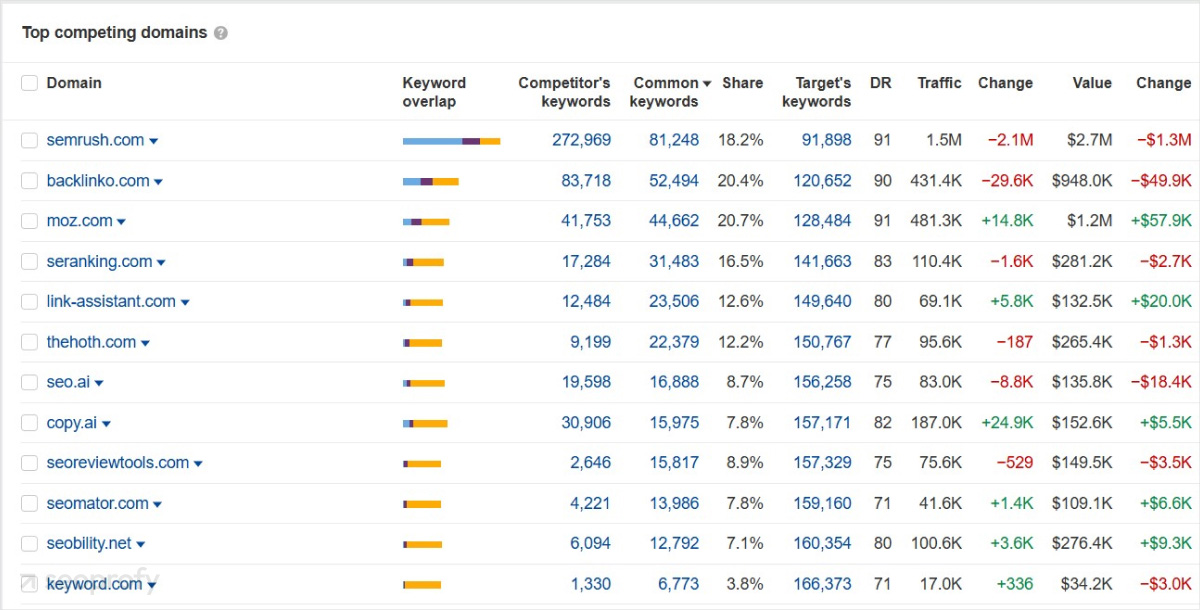
To see what websites link to your competitors but not to you, add your competitors’ domains in the top section of Link Intersect, with your own domain at the bottom. Then, click “Show link opportunities”:
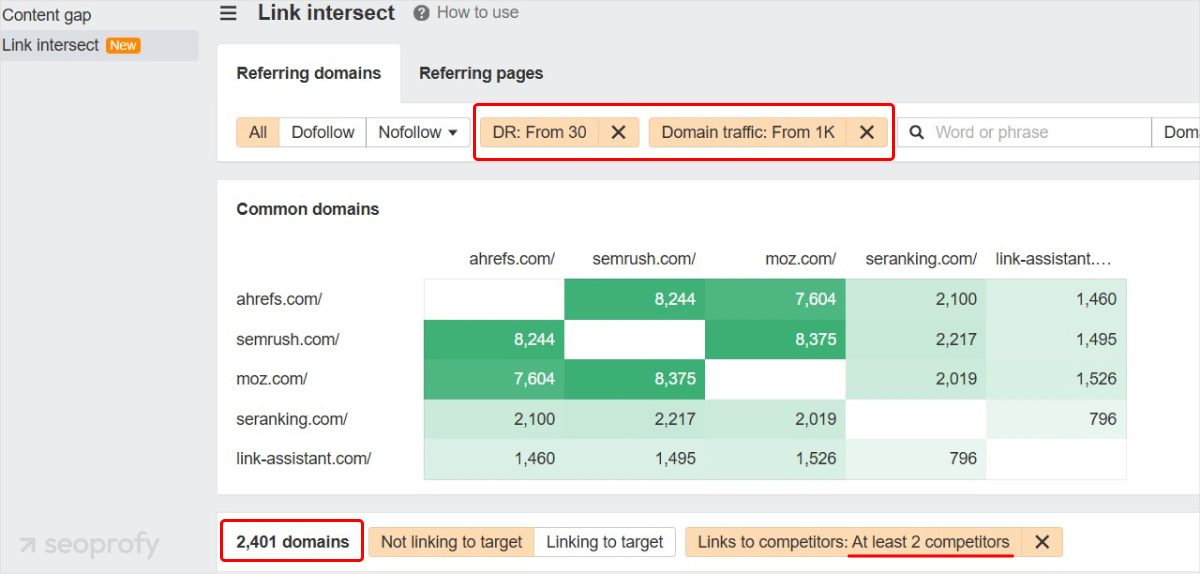
You can then go ahead and reach out to these websites to see if you can get backlinks from them as well (more on that later).
At SeoProfy, we help B2B companies amplify their visibility, attract decision-makers, and turn traffic into business opportunities. Our expert SEO tactics and custom-built tools enable you to see:
- Improved rankings for main keywords
- Increased visits to high-priority pages
- More qualified traffic from organic search

Step 4: Perform Technical SEO Audit
When a website has many pages like detailed product descriptions, case studies, blog posts, and landing pages, it’s easy for things to go wrong. While search engines love rich, helpful content, they can only rank it if they can access and index it properly.
A technical SEO audit clears the path for your content to appear in search results. If human error or technical issues are causing problems, an audit will identify exactly where they are and what needs fixing.
Start with a Site Crawl Using Screaming Frog
This tool highlights broken links, duplicate content (a common problem in B2B ecommerce SEO), slow-loading pages, and many more. The best part is that it’s free to use for up to 500 URLs. So how do you get started with this tool? First, you’ll need to download and install their SEO spider.
Then, enter your website’s URL in the search bar and click ‘Start.” The tool will crawl your site and simulate how search engines scan your pages.
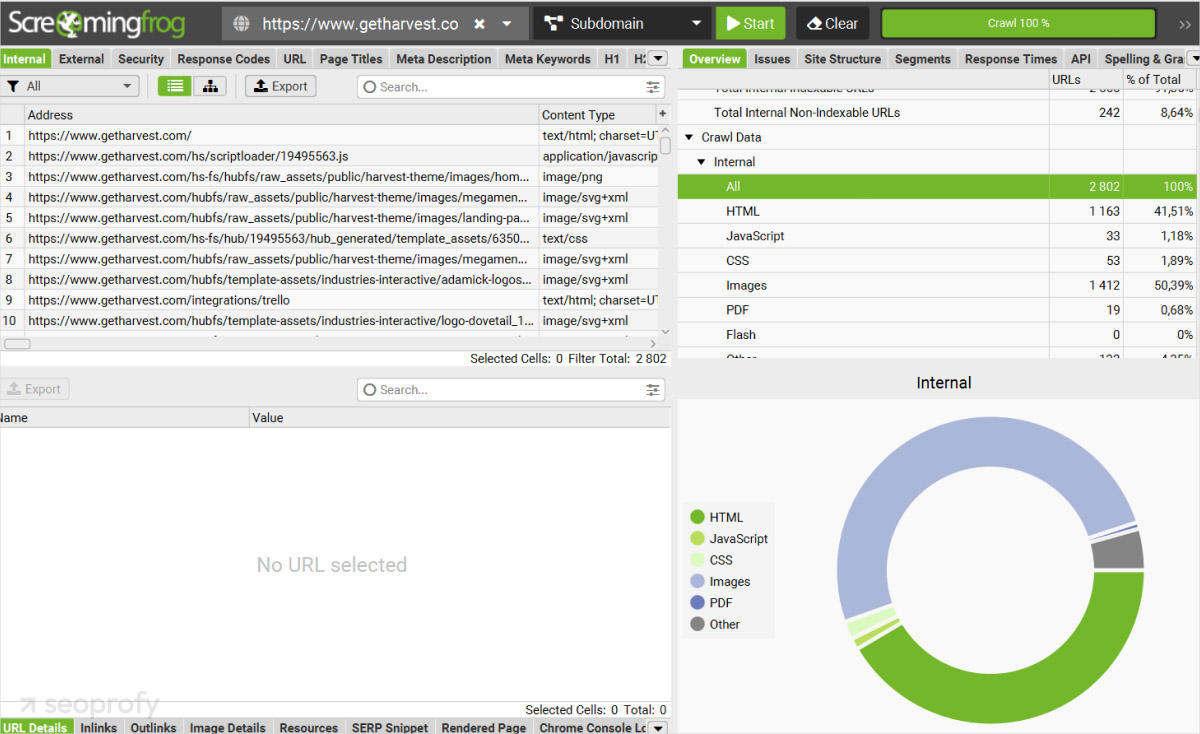
Once the crawl is complete, the first thing you can do is check for broken links. To do this:
- Go to the Response Codes tab
- Filter the list to show “Client Error (4xx)” pages
- Export the list and review the URLs
- Fix the links or update them to point to active pages
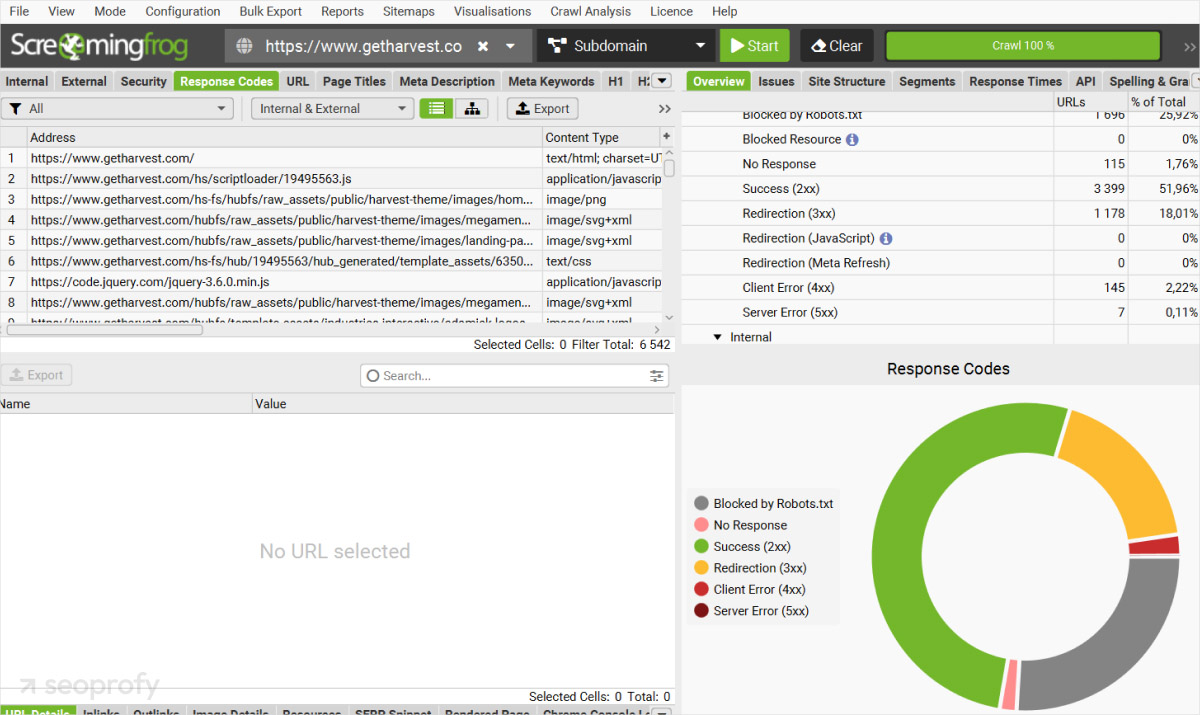
Check Your Site’s Speed and Mobile-Friendliness
Google prioritizes the mobile version of your site when determining rankings and is using mobile-first indexing. If your site isn’t responsive on mobile or has usability issues, it can hurt your rankings even if your desktop version is flawless.
Use Google PageSpeed Insights to identify elements slowing your pages down, such as oversized images:
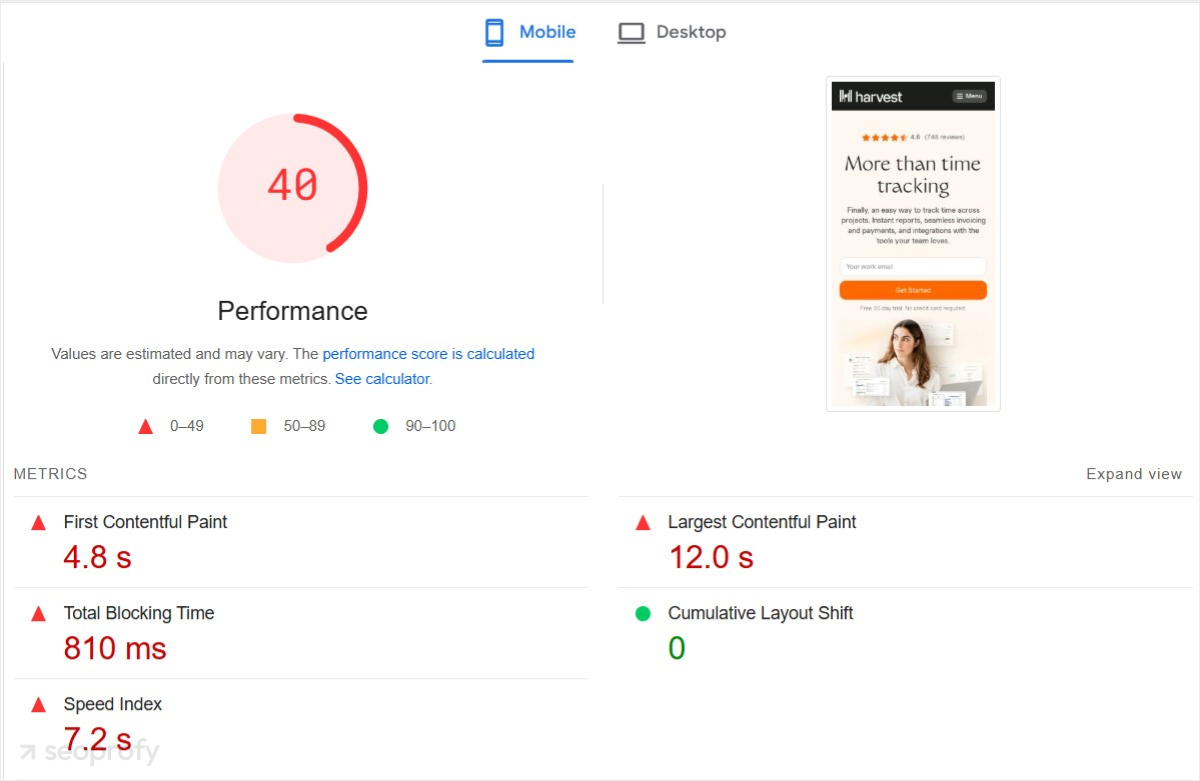
What’s great about this tool is that it also gives you detailed diagnostics as well as actionable tips on how to improve your performance:
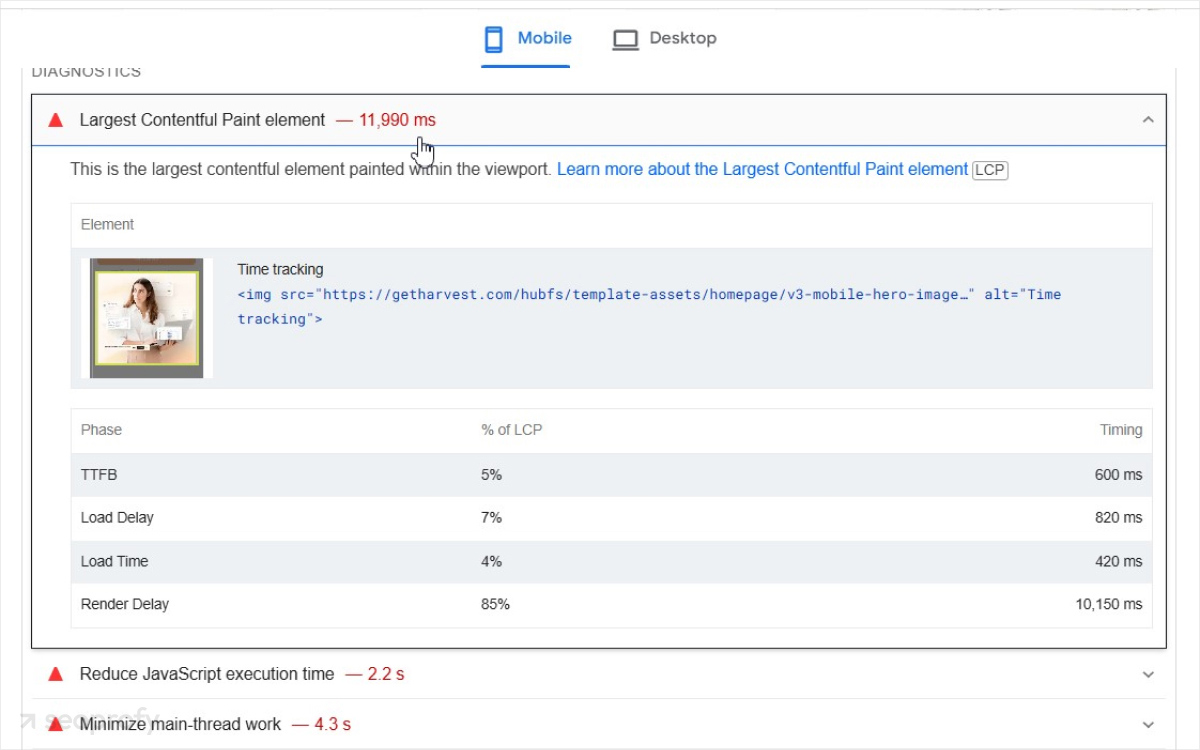
Overall, every SEO strategy for B2B should aim for faster sites, as they tend to rank higher and lead to better user experience (UX). Here are some best practices you can use to speed up your site:
- Compress images with tools such as Squoosh to shrink file sizes without losing quality. Switching to WebP format can also improve load times, as these are approximately 26% smaller than PNGs.
- Simplify your code and reduce unnecessary JavaScript or CSS. Tools like Minify make this quick and easy.
- Set up caching with the W3 Total Cache plugin or adjust your server settings. What it does is speed up the page load times for returning visitors.
- Use a CDN such as Cloudflare to deliver content from servers closer to your visitors.
- Use the <picture> element or the “srcset” attribute in your <img> tag to show responsive image sizes for different screens.
Now that you know how to make your site run efficiently, we can move on to our final step.
Make Sure Your Main Pages are Getting Crawled and Indexed
Search engines use bots, called crawlers, to explore websites. These crawlers follow links to find pages and figure out how they’re connected.
After that, search engines save a page in their database so it can show up in search results (also known as indexing). If a page isn’t indexed, it won’t appear when someone searches for a certain keyword.
You can use Google Search Console to check for any crawling errors. Simply navigate to Settings and click on “Open Report” next to crawl stats:
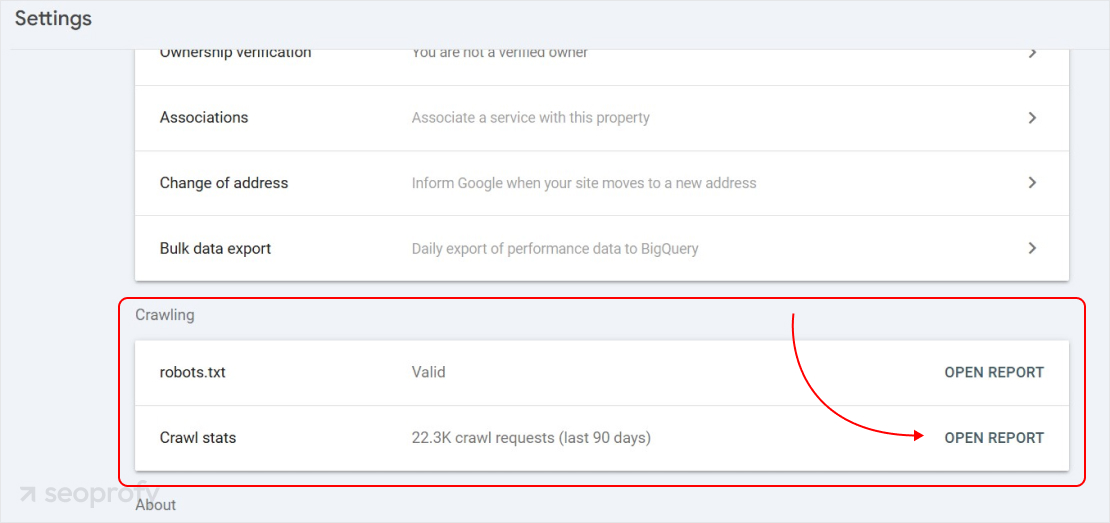
In general, we recommend doing a technical audit regularly so your site stays optimized, loads quickly, and your key pages are shown in search results.
If you don’t have in-house B2B SEO experts or don’t have enough skills or time to do it yourself, you can always outsource it to a professional SEO agency.
Step 5: Conduct Targeted Keyword Research
Keyword research helps you find the words and phrases that are highly relevant for your business and can drive qualified traffic to your site.
Since you already have your customer personas, finding the right search term for each stage of their buyer’s journey is the next logical step for your B2B SEO strategy.
Begin by Brainstorming Ideas
For initial research, you can use your seed keyword to find other terms related to it. Answer the Public is a perfect tool for this step.
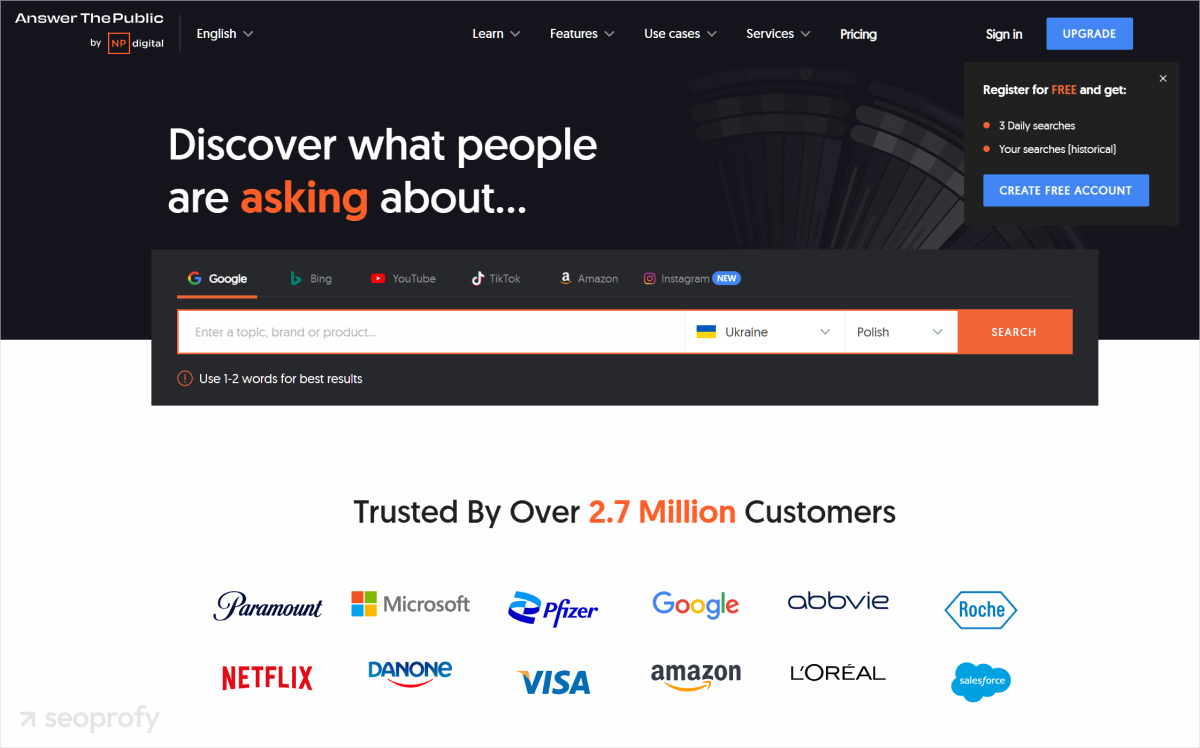
To use it, simply type in your keyword and click “Search.” The results will show you questions, prepositions and related terms that people are searching for. What’s more, you can find here metrics like search volume and CPC, so you can see how popular and competitive each keyword is.
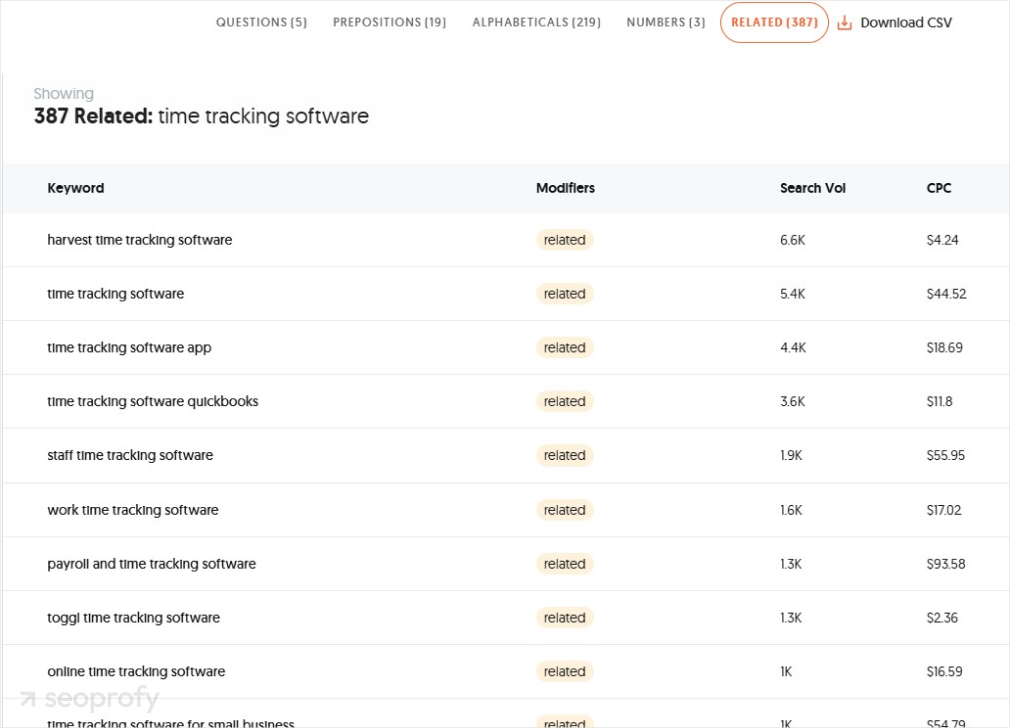
Another tool you can use for your B2B SEO is Google Trends. Here, you can see the trend growth of a certain query. Simply type in the keyword of your interest, select the region and timeframe, and it’ll show you related topics, rising trends, and regional interest.
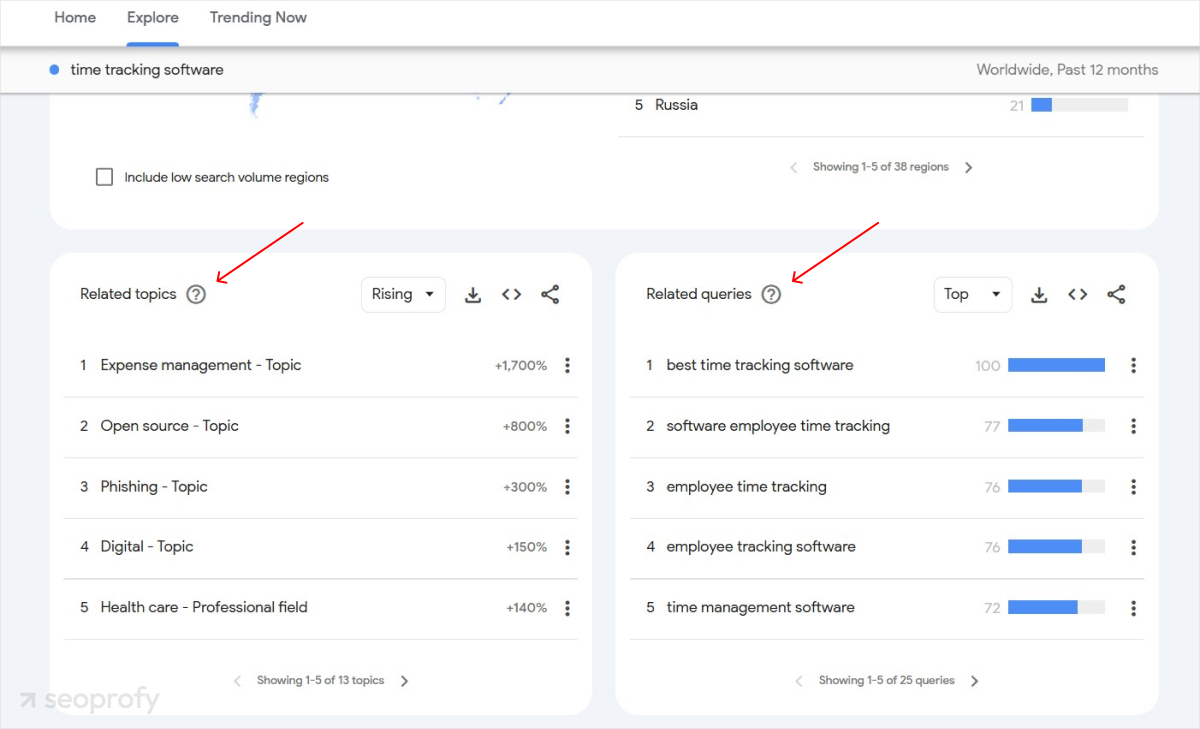
It’s a great way to find popular keywords and also check the countries where there’s more interest in it.
Use SEO Tools Like Ahrefs or Semrush
These tools are more comprehensive and will show you much more metrics in comparison to previous ones. Think keyword difficulty, search volume, traffic potential, question ideas, and many more. Here’s how it looks in Ahrefs:
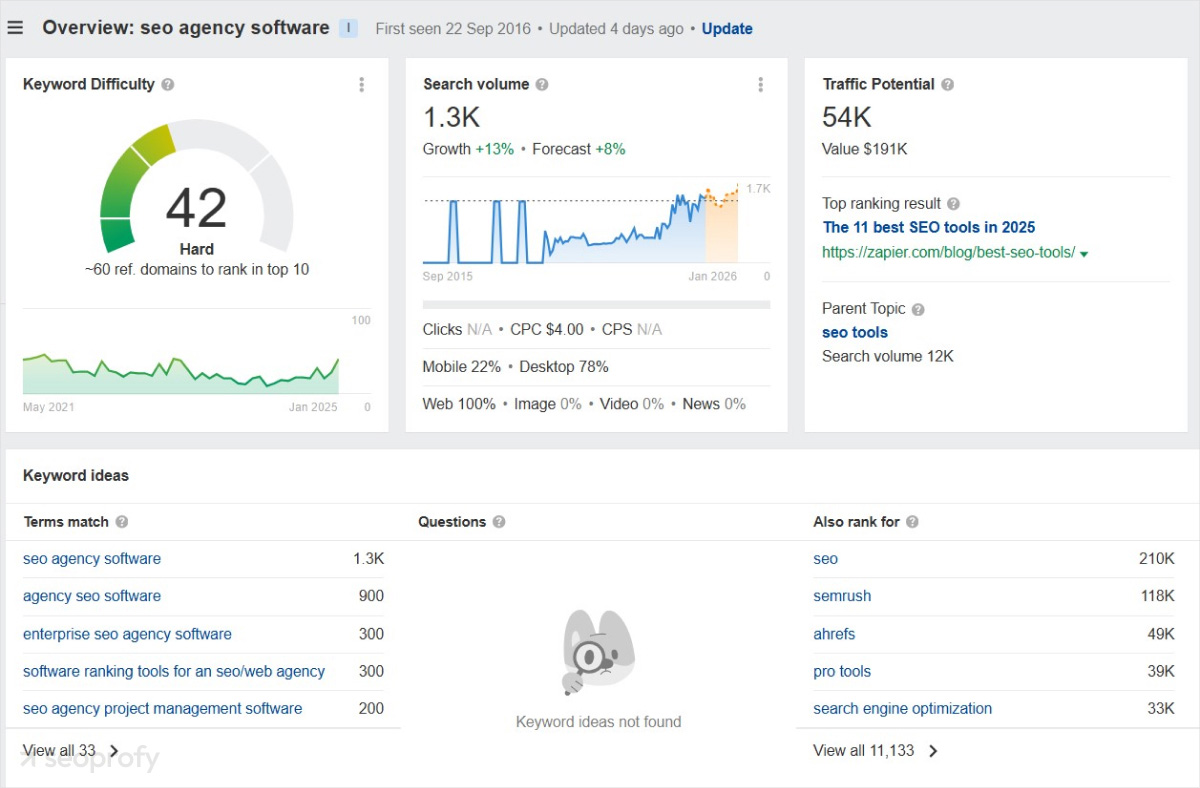
Once you have your list of keyword ideas, you can narrow it down with the help of filters. Some of the main metrics to keep in mind for your B2B SEO strategies are:
- Keyword Difficulty. For newer or less authoritative websites, start with a KD score under 20. This narrows the list to terms where you have a better chance of ranking.
- Search Volume. Adjust the Search Volume filter to remove keywords with very low traffic potential.
- Specific words related to search intent. Find keywords that align more with the intent you’re trying to target. Informational (how, what, guide), transactional intent ( pricing, buy, or demo), and commercial intent (vs. best or top).
Skip low-value terms in your keyword strategy or anything that isn’t relevant to your business. Pay attention to those with commercial intent.
Organize Your Keywords in Topic Clusters
A great way to build topical authority and rank for a wide range of related terms is by using keyword clusters. This is when you group terms around a central topic. Let’s take the example of “time tracking software.”
Your pillar page could be “The Complete Guide to Time Tracking Software.” This page would provide a high-level overview, including what time tracking software is, why it’s important for businesses, and the main features to look for.
Then, you’d create cluster pages that expand on specific aspects of the topic. For example:
- “How Time Tracking Software Increases Productivity for Remote Teams”
- “Best Time Tracking Software for Freelancers”
- “Top Features of Time Tracking Tools for Small Businesses”
Each cluster page links back to the pillar page and vice versa, forming a web of connected content. This structure signals to search engines that your site provides in-depth coverage of the topic.
At the same time, it provides a clear direction for your audience to explore your content, whether they’re just starting their research or comparing tools to buy.
Step 6: Optimize Website Pages for Each Funnel Stage
Your website pages must meet your audience’s needs at every stage of their buying journey. Let’s look at how you can do it:
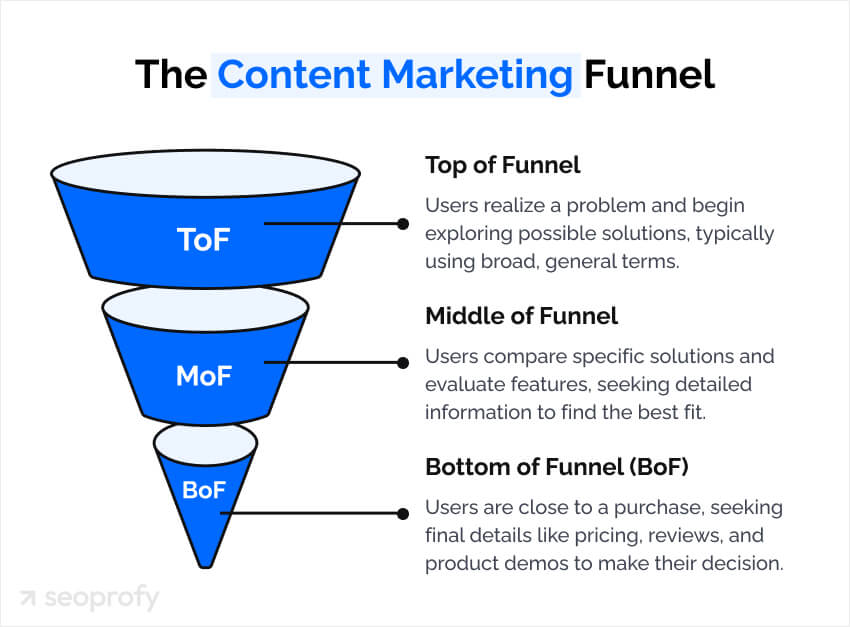
Top of Funnel (Awareness)
At the top of the funnel, prospective clients look for information. In other words, they’re researching. This is when you need to introduce them to your business with the help of blog posts, guides, and explainer content.
Use the informational keywords identified during keyword research to answer questions your audience is asking. Additionally, place internal links to guide them to related resources so they can learn more and stay on your site longer.
Middle of Funnel (Consideration)
Further along the buyer’s journey, people are more specific with their searches. They know they have a problem and now want to compare their options. This is where your content should highlight:
- Why is your solution better?
- What features or benefits set it apart?
- How has it helped other businesses?
As for the formats, comparison pages, case studies, use cases, and product feature guides work best for this stage. You can also include relevant CTA sections within your content to nudge visitors toward engaging with your brand.
Bottom of Funnel (Decision)
At the bottom of the funnel, prospects are ready to make a purchase. Your pages should remove any remaining doubts and make it easy for them to act. You’ll want to give them answers to questions like:
- What’s the cost?
- How can this solution/service benefit me?
- How do I get started?
For this, you’ll need to optimize product, pricing, and demo request pages. Include transactional keywords and highlight success stories, testimonials, or ROI metrics.
Step 7: Develop a Scalable Content Strategy
A scalable B2B SEO content strategy is what helps you plan, create, and optimize information on your site to build authority and drive visibility across the buyer’s journey. In the case of B2B businesses, this is mostly your blog, service, and landing pages.
So where do you start? Well, by now you should have all the ingredients that are needed for your B2B SEO strategy. You have a list of keywords, you understand who your ideal customer is, and you know how to optimize pages for each stage of the marketing funnel. This already gives you a great start for creating a strategy.
To get even more ideas for your content, you can use Ahref’s Content Explorer. All you need to do is paste your seed keyword.
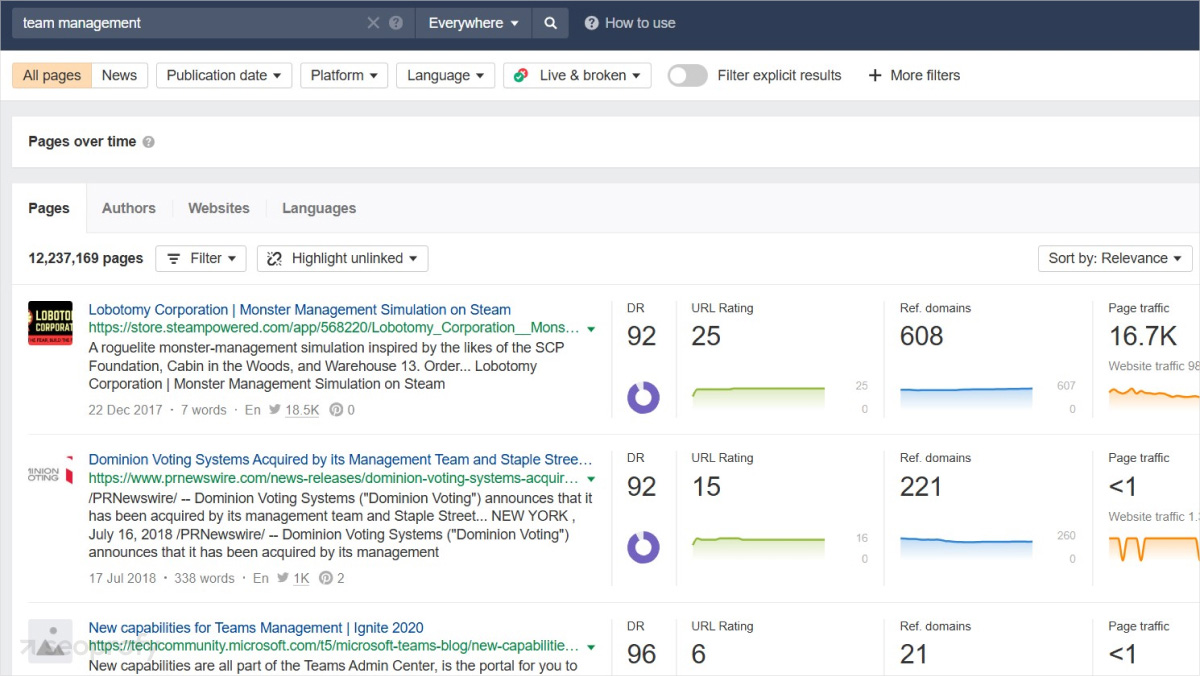
The tool will show you articles that already perform well in search engine results. You can also filter these to find low-competition topics (the ones that get lots of organic traffic but don’t have many backlinks pointing to them):
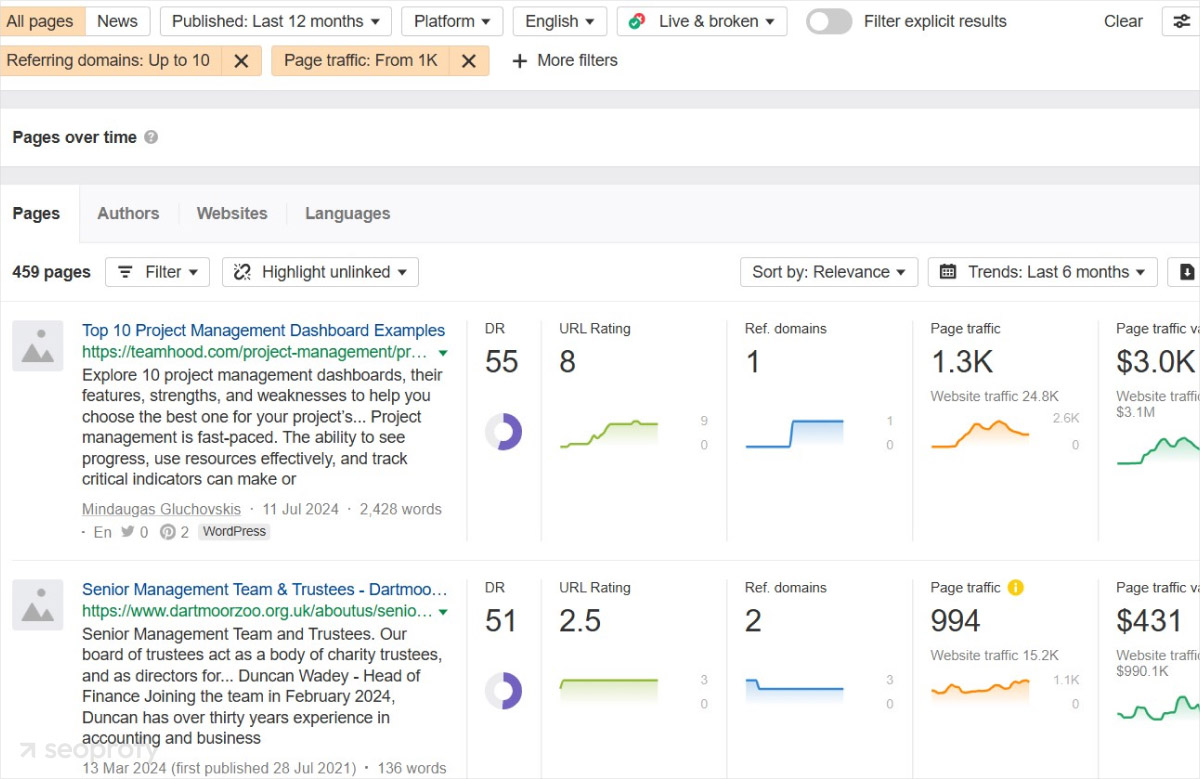
Additionally, you can monitor your competitors’ publishing frequency to see how often they’re adding new pieces:
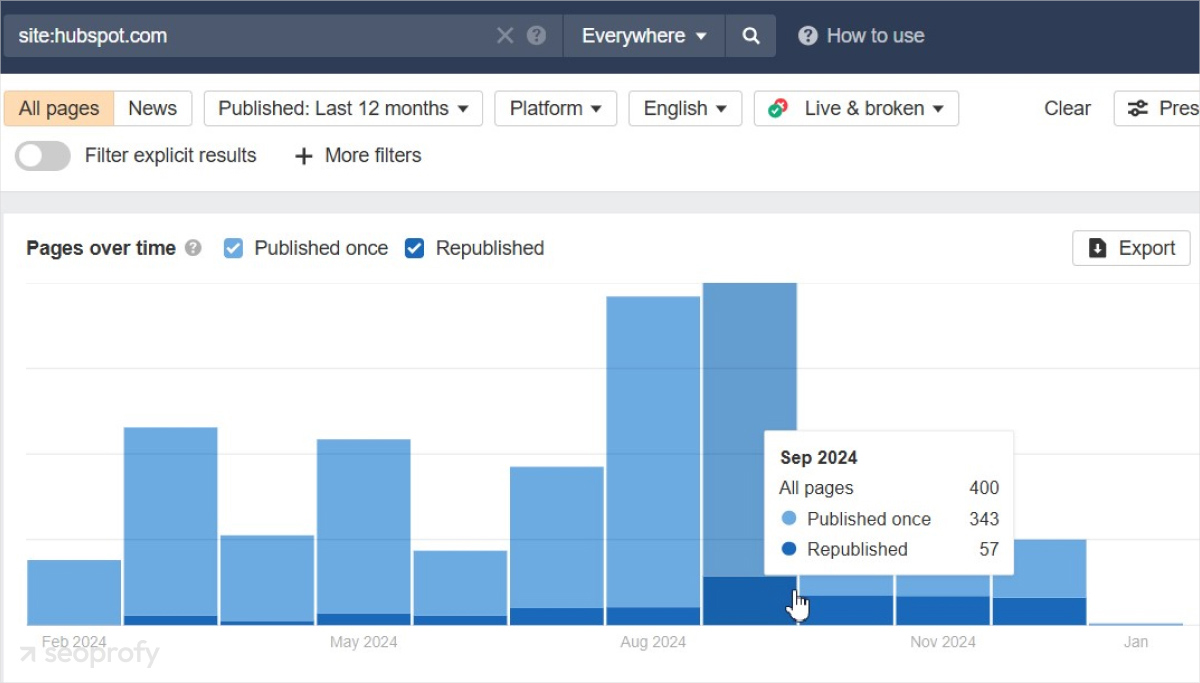
Plan Diverse Content Formats
Once you identify content ideas, you can start working on your editorial plan. Remember though that your SEO content strategy shouldn’t stop at blog posts. Decision-makers often engage with a mix of content formats, so expand your efforts to include:
- Case studies
- White papers
- Ebooks
- Videos
- Webinars
Optimize Content for Longevity
Scalable content isn’t one-and-done. You’ll need to regularly revisit and update your content with new insights, data, or case studies to keep them relevant. You’d also want to renew the internal links and check if keywords are still performing well, too.
Step 8: Earn High-Quality Backlinks
Backlinks are links from other websites that point to you. They serve as recommendations, telling search engines that your content is of excellent quality.
According to our SEO statistics, 92% of marketers claim link building will remain one of the most important ranking factors in the following years.
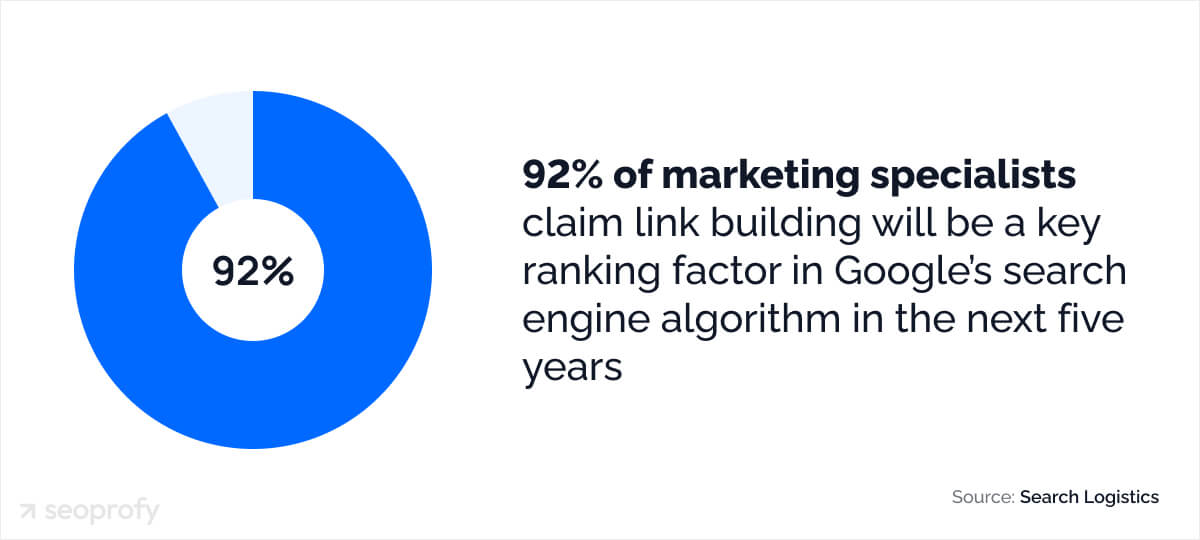
With that being said, let’s explore ways to help you get quality backlinks:
Create Content that People Want to Link to
Think about the kind of resources your audience needs. Original research, case studies, infographics, templates, free tools, and data-driven reports are particularly appealing for backlinks. For example, HubSpot consistently publishes original research like their State of Marketing Report.
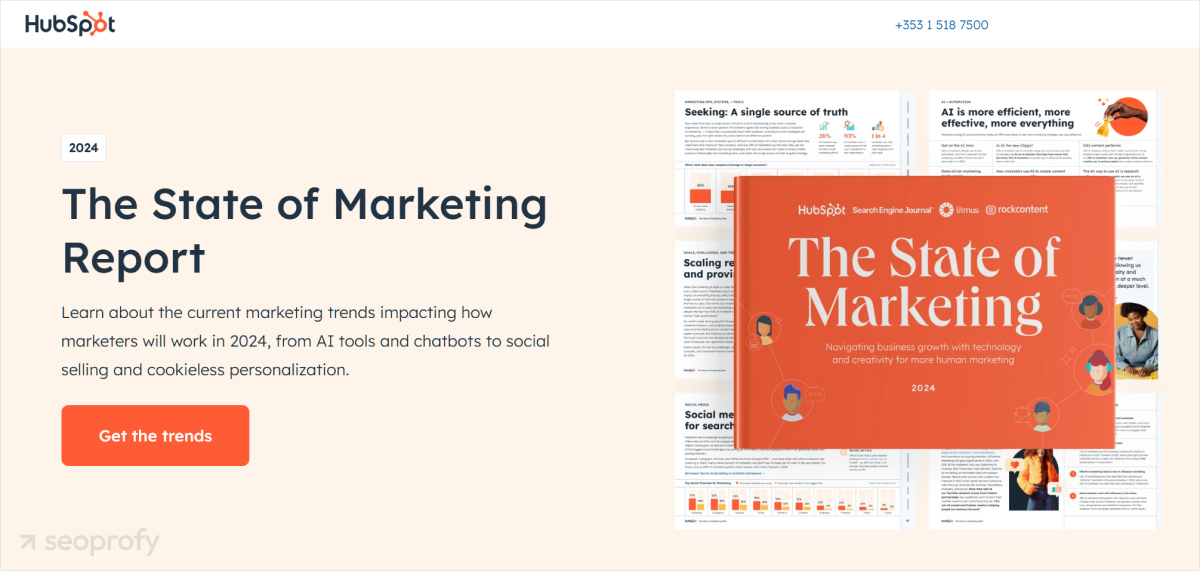
This report is widely referenced by blogs, agencies, and other marketers. We personally linked to it in one of our articles, and 8,100 domains did the same.

Use Proven Outreach Techniques
Guest posting is often the best method for getting backlinks. But it isn’t about sending the same email to tons of websites and asking them to post your piece. You’ll want to be more specific and:
- Look for the right sites. Use tools like Ahrefs to find blogs, trade sites, or news pages where your content fits naturally.
- Make it worth their while. Show them how your content adds value to their site or offers something helpful for their readers.
- Follow up. Many opportunities are missed simply because no one follows up. A polite nudge can often turn a “maybe” into a “yes.”
Reach Out to Partners and Industry Directories
Don’t overlook the easy ways to get backlinks. If you work with vendors, partners, or are part of any trade groups, ask them to link to your site. These are often missed but can be some of the most valuable links you’ll get.
Take Salesforce, for example—they use their partnerships and sponsorships to get backlinks. Being involved in business groups or events often gets them links from trusted websites.
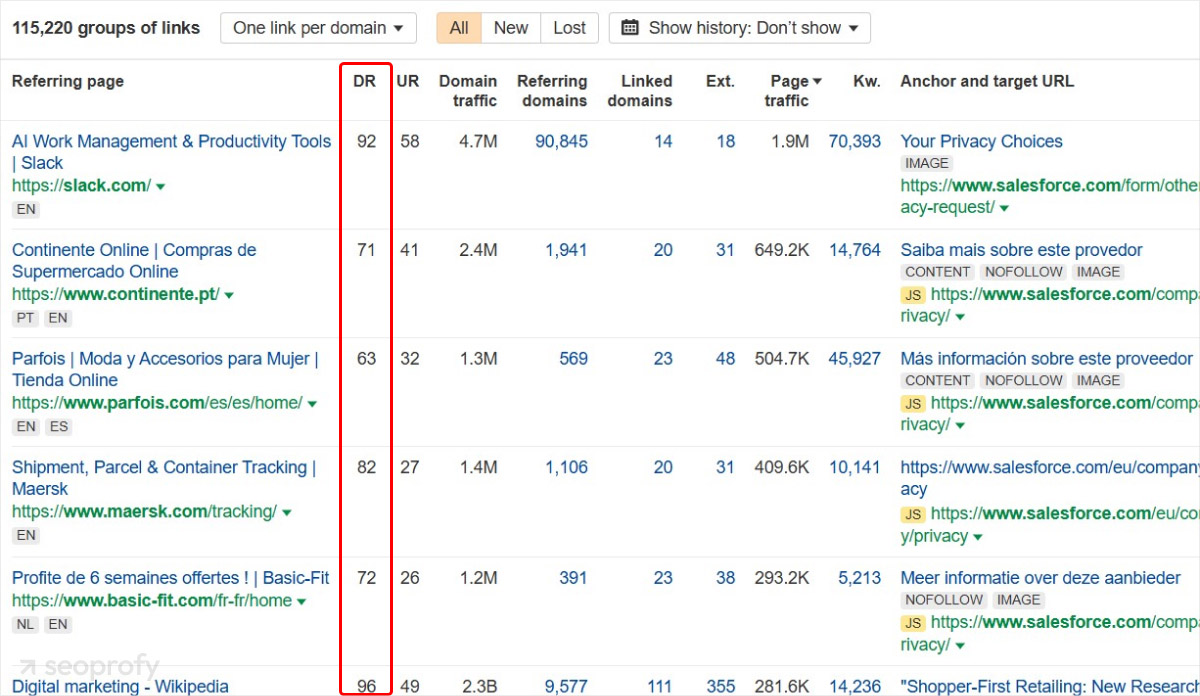
Participate in Joint Webinars and Events
Hosting webinars or joint events is another tested means in SEO for B2B marketing. You can partner with a company whose services complement your offerings and have a similar target audience.
How it works is that you and your partner build event pages on your websites with information about the webinar or event, linking to each other’s resources. Then, you can promote that event through email, blogs, and social media.
Step 9: Optimize for Conversions
Getting people to your website is great, but if they’re not taking action, you’ll need to help them become customers with conversion optimization.
Let’s start with forms on your site. Try to keep them simple. Ask for basics only, like their name, email, and maybe a company name. Long forms can turn people off, especially when they’re just starting to learn about you.
Next, make your calls to action (CTAs) easy to find. Use clear phrases like “Watch a Demo” or “Download Your Free Guide,” and put them in visible spots. Visitors should know what to do next without having to look for it. Here’s how Salesforce does it on their product page for small businesses:
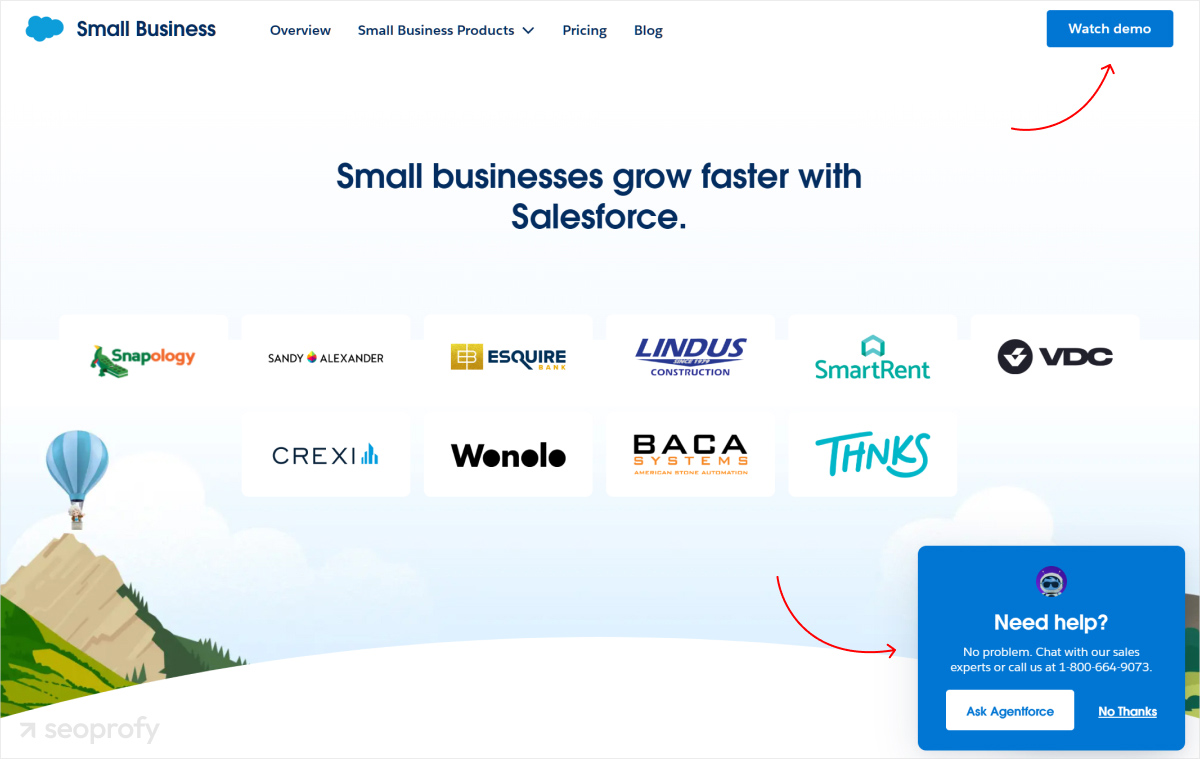
You can test different ideas to see what works. Try changing headlines, CTAs, or layouts to find what gets the best response. For example, does a big CTA at the top get more clicks, or is it better placed after more details?
Finally, to build trust, add some social proof. Share testimonials, case studies, or badges that show your reliability. If you’ve delivered great results for others, highlight those achievements. People are more likely to choose you when they see real evidence of success.
Step 10: Measure, Analyze, and Adjust
SEO for B2B companies requires ongoing attention. It’s important to review your progress, see what’s working well, and then make the necessary adjustments that will maintain and improve those results. Which metrics should you monitor, and what tools can help? Let’s have a look:
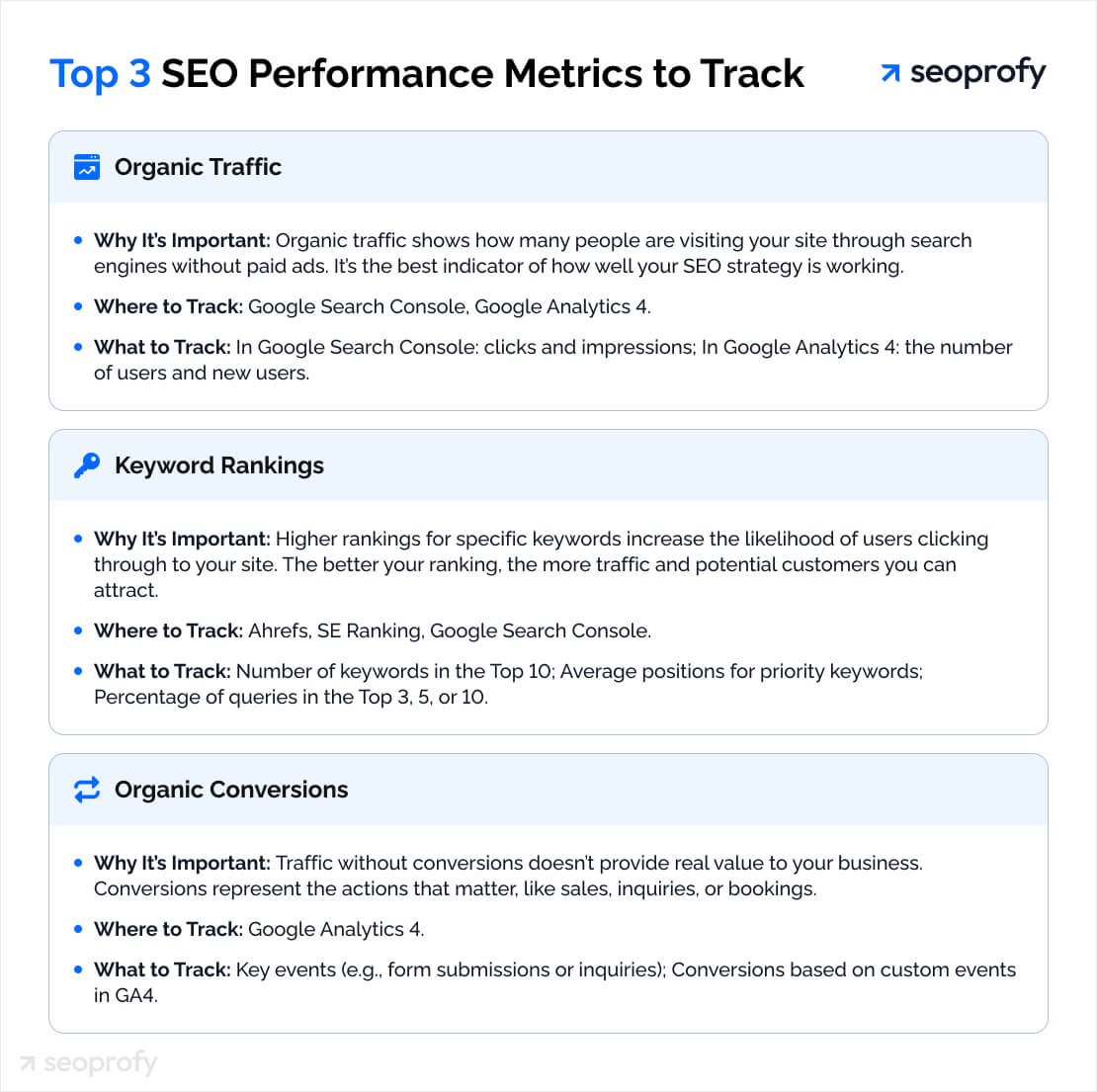
Organic Traffic
In short, this is the amount of visitors that came to your site from search engines through organic results. If you see more traffic, it means your B2B SEO efforts are working. You can use Google Analytics to track it and also look into the following:
- Is traffic growing over time?
- Which pages consistently drive visitors?
- Are there any seasonal patterns?
Keyword Rankings
Ranking well for high-intent keywords means you’re visible to decision-makers who are further down the sales funnel. You can monitor how your target keywords are performing with tools like Ahrefs or Google Search Console. When you look in the report, try to answer these questions:
- Are your priority keywords climbing in rankings?
- Are new competitors outranking you?
- Are there additional keyword opportunities related to your current top performers?
Conversion Rates
Traffic is great, but conversion is what you should be aiming for. Measure actions like form submissions, demo requests, or newsletter sign-ups. Use tools like Google Analytics or a CRM to track conversions and identify which pages get the most clicks. Ask yourself:
- Are visitors following the paths you’ve designed for conversions?
- Which pages have the highest and lowest click-through rates?
- Do certain CTAs or layouts have more engagement?
Use these insights to adjust your B2B SEO strategy. If a page has a high bounce rate, it probably doesn’t meet visitors’ expectations. Rework the content to make it more engaging, add missing details, or include more compelling CTAs.
If a keyword isn’t attracting clicks, adjust the content to better align with search intent or consider targeting a variation with less competition.
Start Your B2B SEO Strategy with SeoProfy
Now that you know the importance of SEO for B2B, what content to create, and how to get authoritative websites to link to you, it’s time to map out your plan.
When you’re working on it, pay attention to what your competitors are doing. Look for gaps you can fill. And don’t forget to check your performance regularly to see what’s working and what’s not.
Here, at SeoProfy, we specialize in B2B and enterprise SEO, and we’d be happy to work with you to create and implement a custom strategy that brings more traffic, leads, and sales to your site.



